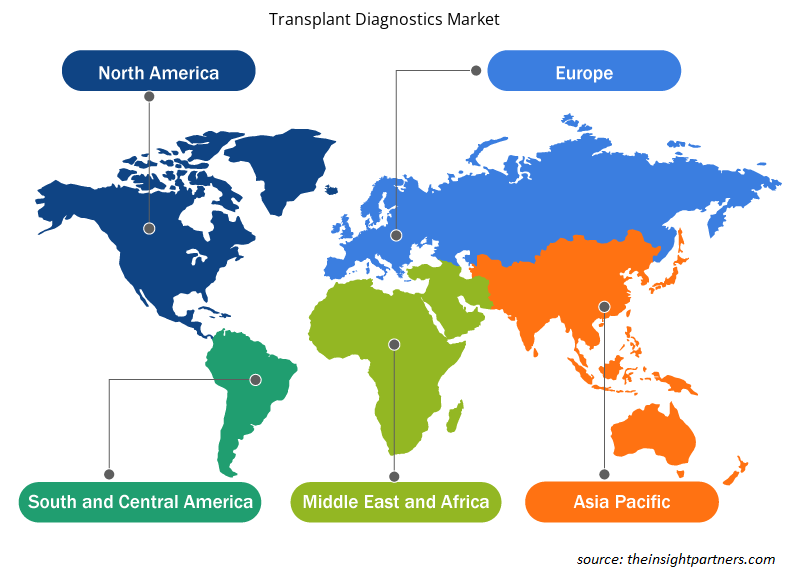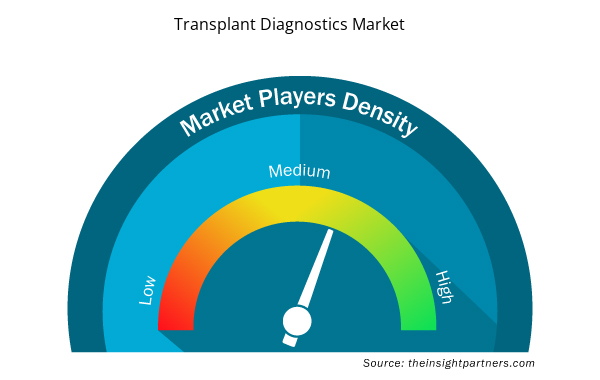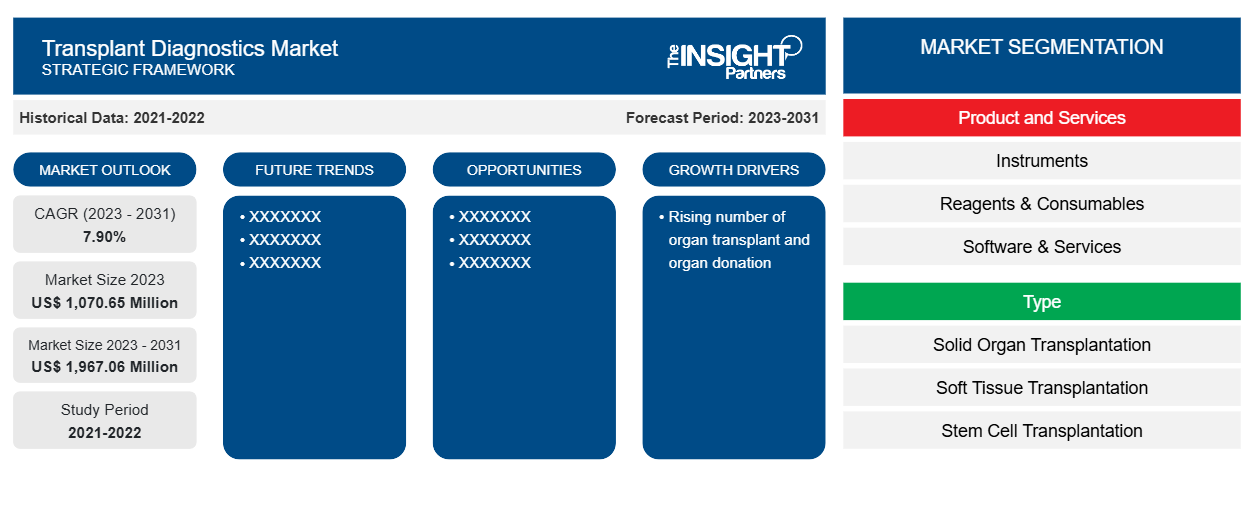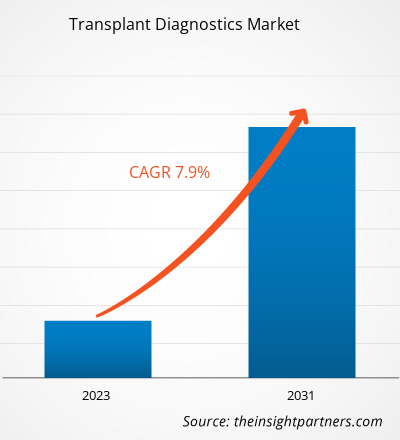Se proyecta que el tamaño del mercado de diagnóstico de trasplantes alcance los 1.967,06 millones de dólares estadounidenses para 2031, frente a los 1.070,65 millones de dólares estadounidenses en 2023. Se espera que el mercado registre una CAGR del 7,90 % entre 2023 y 2031. Se prevé que el creciente número de procedimientos de trasplante de órganos a nivel mundial, como trasplantes de hígado, riñón, corazón y pulmón, impulse la demanda de diagnósticos de trasplantes, lo que a su vez impulsará el crecimiento general del mercado. Además, es probable que la creciente prevalencia de insuficiencias orgánicas y enfermedades crónicas que exigen procedimientos de trasplante sigan siendo tendencias clave del mercado de diagnóstico de trasplantes.
Análisis del mercado de diagnóstico de trasplantes
El trasplante es uno de los tratamientos más preferidos para los pacientes que padecen enfermedades renales y se someten a terapia de diálisis crónica. También es una opción viable que se considera para los pacientes que padecen enfermedades cardíacas o hepáticas. Los diagnósticos en todo el mundo han mejorado significativamente a medida que las empresas han desarrollado mejores tecnologías de tipificación de HLA, monitoreo de anticuerpos, instrumentos y software. Esta tecnología se está utilizando para el diagnóstico durante el trasplante de órganos. El avance en los procedimientos de trasplante ofrece una oportunidad significativa para el crecimiento del mercado.
Descripción general del mercado de diagnóstico de trasplantes
América del Norte es el mayor mercado en cuanto a crecimiento del mercado de diagnóstico de trasplantes, siendo Estados Unidos el que ostenta la mayor cuota de mercado, seguido de Canadá. El crecimiento en América del Norte se caracteriza por el aumento del número de trasplantes de órganos y la creciente prevalencia de fallos orgánicos en esta región. Según datos publicados en United Network for Organ Sharing.org, se estima que en el año 2023 se realizaron aproximadamente 46.630 procedimientos de trasplante en Estados Unidos. De forma similar, según donatelife.net en 2022, Estados Unidos alcanzó un hito histórico, al lograr alrededor de 1 millón de trasplantes de órganos en comparación con cualquier otro país del mundo. En 2023, más de 23.000 donantes trajeron nueva vida a los receptores y sus familias. Además, aproximadamente 100.000 personas están en lista de espera para trasplantes de órganos que les salven la vida. Por tanto, es probable que el creciente número de trasplantes de órganos en el país impulse el crecimiento del mercado en los próximos años.
Personalice este informe según sus necesidades
Obtendrá personalización en cualquier informe, sin cargo, incluidas partes de este informe o análisis a nivel de país, paquete de datos de Excel, así como también grandes ofertas y descuentos para empresas emergentes y universidades.
- Obtenga las principales tendencias clave del mercado de este informe.Esta muestra GRATUITA incluirá análisis de datos, desde tendencias del mercado hasta estimaciones y pronósticos.
Factores impulsores y oportunidades del mercado de diagnóstico de trasplantes
La creciente incidencia de enfermedades crónicas que requieren trasplantes de órganos favorece al mercado
La creciente necesidad de trasplantes de órganos se complementa con la creciente prevalencia de enfermedades crónicas como la diabetes y la enfermedad renal, lo que está impulsando aún más el mercado de diagnósticos de trasplantes. Por ejemplo, según los datos publicados por la Universidad de California en San Francisco, alrededor de 750.000 pacientes en los Estados Unidos y aproximadamente 2 millones de pacientes en todo el mundo se ven afectados por insuficiencia renal cada año. Por lo tanto, con estas fallas orgánicas, la necesidad de riñones de donantes en los EE. UU. también está aumentando a un ritmo del 8% anual. Países como Japón, Taiwán, México, los EE. UU. y Bélgica tienen la prevalencia más alta de insuficiencia renal.
Integración de IA y aprendizaje automático: una oportunidad en el mercado del diagnóstico de trasplantes
Una combinación de inteligencia artificial (IA) y algoritmos de aprendizaje automático ha mostrado resultados prometedores en el mercado de diagnóstico de trasplantes y puede mejorar los resultados de los pacientes, acelerar el análisis de datos y aumentar la precisión del diagnóstico, lo que puede dar lugar a una expansión del mercado. La demanda de trasplantes se ha incrementado debido a varios factores clave, como el envejecimiento de la población, la creciente prevalencia de enfermedades crónicas y los avances en dispositivos médicos que permiten que una gama más amplia de pacientes sean elegibles para el trasplante.
Análisis de segmentación del informe de mercado de diagnóstico de trasplantes
Los segmentos clave que contribuyeron a la derivación del análisis del mercado de diagnóstico de trasplantes son productos y servicios, tipo, tecnología y usuarios finales.
- Según los productos y servicios, el mercado de diagnóstico de trasplantes se segmenta en instrumentos, reactivos y consumibles, y software y servicios. Instrumentos, reactivos y consumibles, y software y servicios. Los reactivos y consumibles tuvieron la mayor participación del mercado en 2023. El software y los servicios registraron la CAGR más alta durante el período de pronóstico 2023-2031.CAGR over the forecast period 2023-2031.
- Por tipo, el mercado está segmentado en trasplante de órganos sólidos , trasplante de tejidos blandos y trasplante de células madre. El segmento de trasplante de órganos sólidos tuvo la mayor participación del mercado en 2023.
- Por tecnología, el mercado está segmentado en ensayos moleculares y ensayos no moleculares. Se espera que el segmento de ensayos moleculares registre la CAGR más alta durante el período de pronóstico.
- Por usuario final, el mercado se segmenta en hospitales y centros de trasplantes, laboratorios de investigación e institutos académicos y laboratorios de referencia independientes. El segmento de hospitales y centros de trasplantes tuvo la mayor participación del mercado en 2023.
Análisis de la cuota de mercado de diagnóstico de trasplantes por geografía
El alcance geográfico del informe del mercado de diagnóstico de trasplantes se divide principalmente en cinco regiones: América del Norte, Asia Pacífico, Europa, Medio Oriente y África, y América del Sur y Central.
América del Norte ha dominado el mercado de diagnóstico de trasplantes. El crecimiento del mercado se puede atribuir a una prevalencia cada vez mayor de insuficiencia orgánica y un número cada vez mayor de donaciones de órganos junto con los procedimientos de trasplante de órganos que impulsan el crecimiento del mercado regional. Por ejemplo, según los datos publicados por la Asociación de Organizaciones de Obtención de Órganos (AOPO), una organización sin fines de lucro en EE. UU., afirma que en enero de 2021, más de 12.500 personas donaron uno o más órganos en 2020, y el número de órganos donados de donantes fallecidos aumentó a más de 36.500, lo que supone un aumento de casi el 2% año tras año. Además, los órganos de los muertos han salvado más de 33.000 vidas en los últimos siete años.
Por lo tanto, el aumento en la donación de órganos crea la necesidad de aumentar las pruebas de diagnóstico de trasplantes y, por lo tanto, impulsa el crecimiento del mercado.
Perspectivas regionales del mercado de diagnóstico de trasplantes
Los analistas de Insight Partners explicaron en detalle las tendencias y los factores regionales que influyen en el mercado de diagnóstico de trasplantes durante el período de pronóstico. Esta sección también analiza los segmentos y la geografía del mercado de diagnóstico de trasplantes en América del Norte, Europa, Asia Pacífico, Oriente Medio y África, y América del Sur y Central.

- Obtenga datos regionales específicos para el mercado de diagnóstico de trasplantes
Alcance del informe de mercado sobre diagnóstico de trasplantes
| Atributo del informe | Detalles |
|---|---|
| Tamaño del mercado en 2023 | US$ 1.070,65 millones |
| Tamaño del mercado en 2031 | US$ 1.967,06 millones |
| CAGR global (2023 - 2031) | 7,90% |
| Datos históricos | 2021-2022 |
| Período de pronóstico | 2023-2031 |
| Segmentos cubiertos | Por productos y servicios
|
| Regiones y países cubiertos | América del norte
|
| Líderes del mercado y perfiles de empresas clave |
|
Densidad de actores del mercado: comprensión de su impacto en la dinámica empresarial
El mercado de diagnóstico de trasplantes está creciendo rápidamente, impulsado por la creciente demanda de los usuarios finales debido a factores como la evolución de las preferencias de los consumidores, los avances tecnológicos y una mayor conciencia de los beneficios del producto. A medida que aumenta la demanda, las empresas amplían sus ofertas, innovan para satisfacer las necesidades de los consumidores y aprovechan las tendencias emergentes, lo que impulsa aún más el crecimiento del mercado.
La densidad de actores del mercado se refiere a la distribución de las empresas o firmas que operan dentro de un mercado o industria en particular. Indica cuántos competidores (actores del mercado) están presentes en un espacio de mercado determinado en relación con su tamaño o valor total de mercado.
Las principales empresas que operan en el mercado de diagnóstico de trasplantes son:
- Laboratorios Bio-Rad,
- Hologico,
- Illumina, Inc.,
- Termo Fisher Scientific,
- QIAGEN NV
- Omixon, Inc.
Descargo de responsabilidad : Las empresas enumeradas anteriormente no están clasificadas en ningún orden particular.

- Obtenga una descripción general de los principales actores clave del mercado de diagnóstico de trasplantes
Noticias y desarrollos recientes del mercado de diagnóstico de trasplantes
El mercado de diagnóstico de trasplantes se evalúa mediante la recopilación de datos cualitativos y cuantitativos posteriores a la investigación primaria y secundaria, que incluye publicaciones corporativas importantes, datos de asociaciones y bases de datos. A continuación, se incluye una lista de los avances en el mercado de diagnóstico de trasplantes:
- Thermo Fisher Scientific incorporó dos nuevos productos a su cartera de diagnóstico de trasplantes durante la conferencia anual de la Sociedad Estadounidense de Histocompatibilidad e Inmunogenética (ASHI). (Fuente: Thermo Fisher Scientific, comunicado de prensa/sitio web de la empresa/boletín informativo, octubre de 2023)
- Immucor, Inc., una empresa especializada en diagnósticos de transfusión y trasplantes, anunció dos incorporaciones a su cartera de diagnósticos de trasplantes, lo que demuestra su compromiso continuo con los nuevos avances en el campo de la histocompatibilidad. (Fuente: Immucor, comunicado de prensa/sitio web de la empresa/boletín informativo, marzo de 2022)
- Biocartis y Ophiomics han iniciado una colaboración para centrarse en la comercialización de HepatoPredict, una prueba pronóstica de expresión genética para identificar qué pacientes se beneficiarán del trasplante de hígado (Fuente: Biocartis, Nota de prensa/Sitio web de la empresa/Boletín informativo, marzo de 2022)
Cobertura y resultados del informe de mercado sobre diagnóstico de trasplantes
El informe “Tamaño y pronóstico del mercado de diagnóstico de trasplantes (2021-2031)” proporciona un análisis detallado del mercado que cubre las siguientes áreas:
- Tamaño del mercado y pronóstico a nivel global, regional y nacional para todos los segmentos clave del mercado cubiertos bajo el alcance
- Dinámica del mercado, como impulsores, restricciones y oportunidades clave
- Principales tendencias futuras
- Análisis detallado de las cinco fuerzas de Porter y PEST y FODA
- Análisis del mercado global y regional que cubre las tendencias clave del mercado, los principales actores, las regulaciones y los desarrollos recientes del mercado.
- Análisis del panorama de la industria y de la competencia que abarca la concentración del mercado, el análisis de mapas de calor, los actores destacados y los desarrollos recientes
- Perfiles detallados de empresas
- Análisis histórico (2 años), año base, pronóstico (7 años) con CAGR
- Análisis PEST y FODA
- Tamaño del mercado Valor/volumen: global, regional, nacional
- Industria y panorama competitivo
- Conjunto de datos de Excel



Report Coverage
Revenue forecast, Company Analysis, Industry landscape, Growth factors, and Trends

Segment Covered
This text is related
to segments covered.

Regional Scope
North America, Europe, Asia Pacific, Middle East & Africa, South & Central America

Country Scope
This text is related
to country scope.
Trends and growth analysis reports related to Life Sciences : READ MORE..
The Insight Partners performs research in 4 major stages: Data Collection & Secondary Research, Primary Research, Data Analysis and Data Triangulation & Final Review.
- Data Collection and Secondary Research:
As a market research and consulting firm operating from a decade, we have published and advised several client across the globe. First step for any study will start with an assessment of currently available data and insights from existing reports. Further, historical and current market information is collected from Investor Presentations, Annual Reports, SEC Filings, etc., and other information related to company’s performance and market positioning are gathered from Paid Databases (Factiva, Hoovers, and Reuters) and various other publications available in public domain.
Several associations trade associates, technical forums, institutes, societies and organization are accessed to gain technical as well as market related insights through their publications such as research papers, blogs and press releases related to the studies are referred to get cues about the market. Further, white papers, journals, magazines, and other news articles published in last 3 years are scrutinized and analyzed to understand the current market trends.
- Primary Research:
The primarily interview analysis comprise of data obtained from industry participants interview and answers to survey questions gathered by in-house primary team.
For primary research, interviews are conducted with industry experts/CEOs/Marketing Managers/VPs/Subject Matter Experts from both demand and supply side to get a 360-degree view of the market. The primary team conducts several interviews based on the complexity of the markets to understand the various market trends and dynamics which makes research more credible and precise.
A typical research interview fulfils the following functions:
- Provides first-hand information on the market size, market trends, growth trends, competitive landscape, and outlook
- Validates and strengthens in-house secondary research findings
- Develops the analysis team’s expertise and market understanding
Primary research involves email interactions and telephone interviews for each market, category, segment, and sub-segment across geographies. The participants who typically take part in such a process include, but are not limited to:
- Industry participants: VPs, business development managers, market intelligence managers and national sales managers
- Outside experts: Valuation experts, research analysts and key opinion leaders specializing in the electronics and semiconductor industry.
Below is the breakup of our primary respondents by company, designation, and region:

Once we receive the confirmation from primary research sources or primary respondents, we finalize the base year market estimation and forecast the data as per the macroeconomic and microeconomic factors assessed during data collection.
- Data Analysis:
Once data is validated through both secondary as well as primary respondents, we finalize the market estimations by hypothesis formulation and factor analysis at regional and country level.
- Macro-Economic Factor Analysis:
We analyse macroeconomic indicators such the gross domestic product (GDP), increase in the demand for goods and services across industries, technological advancement, regional economic growth, governmental policies, the influence of COVID-19, PEST analysis, and other aspects. This analysis aids in setting benchmarks for various nations/regions and approximating market splits. Additionally, the general trend of the aforementioned components aid in determining the market's development possibilities.
- Country Level Data:
Various factors that are especially aligned to the country are taken into account to determine the market size for a certain area and country, including the presence of vendors, such as headquarters and offices, the country's GDP, demand patterns, and industry growth. To comprehend the market dynamics for the nation, a number of growth variables, inhibitors, application areas, and current market trends are researched. The aforementioned elements aid in determining the country's overall market's growth potential.
- Company Profile:
The “Table of Contents” is formulated by listing and analyzing more than 25 - 30 companies operating in the market ecosystem across geographies. However, we profile only 10 companies as a standard practice in our syndicate reports. These 10 companies comprise leading, emerging, and regional players. Nonetheless, our analysis is not restricted to the 10 listed companies, we also analyze other companies present in the market to develop a holistic view and understand the prevailing trends. The “Company Profiles” section in the report covers key facts, business description, products & services, financial information, SWOT analysis, and key developments. The financial information presented is extracted from the annual reports and official documents of the publicly listed companies. Upon collecting the information for the sections of respective companies, we verify them via various primary sources and then compile the data in respective company profiles. The company level information helps us in deriving the base number as well as in forecasting the market size.
- Developing Base Number:
Aggregation of sales statistics (2020-2022) and macro-economic factor, and other secondary and primary research insights are utilized to arrive at base number and related market shares for 2022. The data gaps are identified in this step and relevant market data is analyzed, collected from paid primary interviews or databases. On finalizing the base year market size, forecasts are developed on the basis of macro-economic, industry and market growth factors and company level analysis.
- Data Triangulation and Final Review:
The market findings and base year market size calculations are validated from supply as well as demand side. Demand side validations are based on macro-economic factor analysis and benchmarks for respective regions and countries. In case of supply side validations, revenues of major companies are estimated (in case not available) based on industry benchmark, approximate number of employees, product portfolio, and primary interviews revenues are gathered. Further revenue from target product/service segment is assessed to avoid overshooting of market statistics. In case of heavy deviations between supply and demand side values, all thes steps are repeated to achieve synchronization.
We follow an iterative model, wherein we share our research findings with Subject Matter Experts (SME’s) and Key Opinion Leaders (KOLs) until consensus view of the market is not formulated – this model negates any drastic deviation in the opinions of experts. Only validated and universally acceptable research findings are quoted in our reports.
We have important check points that we use to validate our research findings – which we call – data triangulation, where we validate the information, we generate from secondary sources with primary interviews and then we re-validate with our internal data bases and Subject matter experts. This comprehensive model enables us to deliver high quality, reliable data in shortest possible time.


 Obtenga una muestra gratuita de este informe
Obtenga una muestra gratuita de este informe